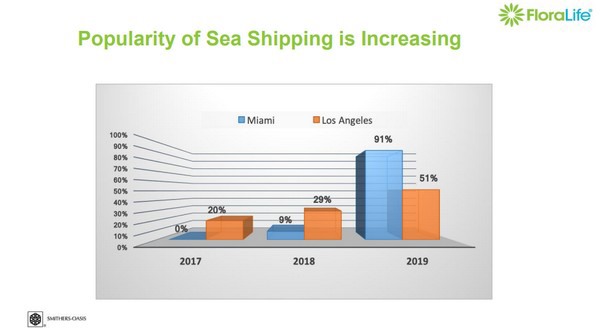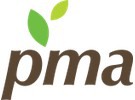The popularity of sea shipping is on the rise for several years now and the COVID-19 crisis seem to fuel this trend. During the May 27 virtual Floral Roundtable hosted by Produce Marketing Association (PMA), floral retailers, growers, transportation and processing experts discussed logistics of sea freight and floral consolidation centers and how both can help create efficiencies, reduce carbon footprint, and help get high-quality cut flowers to market for U.S. consumers.
PMA has facilitated conversations about sea transport of floral for a couple of years, and – like much else – repercussions from COVID-19 on the industry have brought the conversation to the forefront again and could accelerate change. PMA’s role is to provide access to transportation information, so retailers have a better understanding of options and general considerations as they consider alternatives.
Much of floral imports to the United States from Latin America come by air. As a result of COVID-19 and related travel restrictions and limited southbound flights, some air cargo carriers are facing significant financial stress, including potential Chapter 11. In normal times during peak floral holidays, airlines stretch in order to meet floral transport demand to the United States. Fuel costs for air freight are a concern during peak demand times. Also, as the dollar goes up, less cargo flights head south and availability of planes declines, which drives up cost.

Popularity of sea shipping is increasing
Sea freight has been in place in Europe for many years. Since 2017, sea freight coming into Miami, Fla., and into Los Angeles, Calif., on the West Coast of the United States has increased, explains Steve Daum of Floralife. In his PowerPoint presentation, he show this increase in popularity of sea shipping at the ports of Miami and Los Angeles. Other viable ports for floral import include Philadelphia. Furthermore, he explains that there are risks, and that it is vitally important to choose the right supply partners who know what the protocols are for sea transport. Sea transport can take about 9 to 12 days and certain flower types and varieties are better suited for transport by sea than others. Important to notice is that longer lead times require retailers to plan and order earlier.
The shipment
Post-harvest treatment is critical, including need for high water quality. Some farms have dedicated teams that handle only crops to be transported by sea freight. There are added costs from farm to shipping container, so cost savings isn’t a driving factor during non peak floral holidays. Infrastructure includes temperature-controlled rooms. Sea transport requires special sleeves, ventilated boxes, low-vibration containers, and the proper cooling systems to let relative humidity leave the product. Modified atmosphere packaging is precooled and the number of bunches per box is limited to facilitate air circulation. Vent holes must line up, and pallet loading protocol must be followed. Shippers also use remote monitoring for temperature control.
Unbroken cold chain
Cut flowers that are suited for shipping by sea and are properly shipped with an unbroken cold chain are high quality and have good vase life. About 80 percent of flowers coming by sea from Colombia are now x-rayed for inspection rather than boxes being opened, which maintains the cold chain and improves flower quality. Other factors that improve quality are having knowledgeable people on the receiving end, such as inspectors, as well as processors who know how to rehydrate flowers. Cut flowers shipped by sea aren’t as fully bloomed, but they open beautifully once rehydrated. Getting flowers to distribution centers quickly is also important.
For more information on transporting floral by sea freight, see this presentation which was shared during our roundtable.
Retailers and growers evaluating benefits and challenges
Retailers on the call said there is an opportunity for retailers of all sizes across the United States to evaluate options for sea transport and get a better understanding of benefits and challenges. Improving product flow and ensuring high-quality flowers are available year-round will benefit everyone. Some growers are further advanced that others in terms of planning and post-harvest of flowers destined for sea transport, but there’s an opportunity for other farmers to learn and advance as well. Understanding which varieties can be shipped by sea, partner capabilities and ordering schedules is important to make any directional shifts.
Bottom line for retailers considering receiving product by sea freight: research transportation, get a sound understanding of varieties that ship well, explore growers’ capabilities and expertise regarding planting and post-harvest, and plan ahead.
Options to explore include use of consolidation centers
Floral consolidation centers can also be helpful to both suppliers and retailers. Such centers, and there are about 20 in the United States, are an extension of floral growers’ operational teams. Consolidation centers can receive dry-packed floral product by air, sea or truck. Flowers are processed closer to retailers and are in water much quicker. They can be especially helpful for retailers who are light on labor and are unable to process dry-packed flowers at store level. Processing at consolidation centers helps alleviate labor issues at the store and promotes freshness and sustainability. Consolidated transportation improves routing efficiencies as well.
Click here to register for next week's Wednesday June 3, 2020 virtual floral roundtable.
For more information PMA
PMA
www.pma.com
